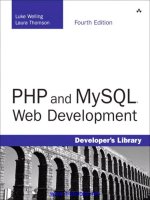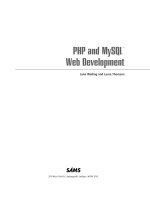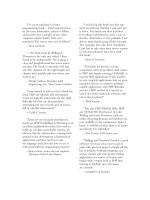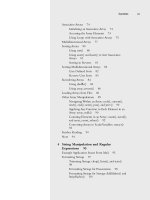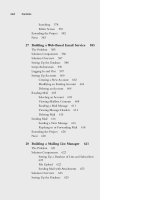PHP and MySQL Web Development - P143 pot
Bạn đang xem bản rút gọn của tài liệu. Xem và tải ngay bản đầy đủ của tài liệu tại đây (167.35 KB, 5 trang )
682
Chapter 29 Building Web Forums
What we see here are all the initiating articles. None of these are replies; they are all the
first article on a particular topic.
You will see that we have a number of options.There is a menu bar that will let us
add a new post and expand or collapse the view that we have of the articles.
To understand what this means, look at the posts. Some of them have plus symbols
next to them.This means that these articles have been replied to.To see the replies to a
particular article, you can click the plus symbol.The result of clicking one of these sym-
bols is shown in Figure 29.5.
Figure 29.5 The thread of discussion about persistence has been expanded.
As you can see, clicking the plus symbol has displayed the replies to that first article.The
plus symbol has now turned to a minus symbol. If we click this, all the articles in this
thread will be collapsed, returning us to the initial view.
You might also notice that one of the replies has a plus symbol next to it.This means
that there are replies to this reply.This can continue to an arbitrary depth, and you can
view each reply set by clicking on the appropriate plus symbol.
The two menu bar options, Expand and Collapse, will expand all possible threads and
collapse all possible threads, respectively.The result of clicking the Expand button is
shown in Figure 29.6.
35 525x ch29 1/24/03 3:36 PM Page 682
683
Viewing the Tree of Articles
Figure 29.6 All the threads have now been expanded.
If you look closely at Figures 29.5 and 29.6, you can see that we are passing some
parameters back to index.php in the command line. In Figure 29.5, the URL looks as
follows:
http://webserver/chapter29/index.php?expand=6#6
The script reads this as “Expand the item with postid 6”.The # is just an HTML anchor
that will scroll the page down to the part that has just been expanded.
In Figure 29.6, the URL reads
http://webserver/chapter29/index.php?expand=all
Clicking the Expand button has passed the parameter expand with the value all.
Expanding and Collapsing
Let’s see how it’s done by looking at the index.php script, shown in Listing 29.2.
Listing 29.2 index.php—Script to Create the Article View on the Main Page of the
Application
<?php
include ('include_fns.php');
session_start();
// check if we have created our session variable
if(!isset($HTTP_SESSION_VARS['expanded']))
35 525x ch29 1/24/03 3:36 PM Page 683
684
Chapter 29 Building Web Forums
{
$HTTP_SESSION_VARS['expanded'] = array();
}
// check if an expand button was pressed
// expand might equal 'all' or a postid or not be set
if(isset($HTTP_GET_VARS['expand']))
{
if($HTTP_GET_VARS['expand'] == 'all')
expand_all($HTTP_SESSION_VARS['expanded']);
else
$HTTP_SESSION_VARS['expanded'][$HTTP_GET_VARS['expand']] = true;
}
// check if a collapse button was pressed
// collapse might equal all or a postid or not be set
if(isset($HTTP_GET_VARS['collapse']))
{
if($HTTP_GET_VARS['collapse']=='all')
$HTTP_SESSION_VARS['expanded'] = array();
else
unset($HTTP_SESSION_VARS['expanded'][$HTTP_GET_VARS['collapse']]);
}
do_html_header('Discussion Posts');
display_index_toolbar();
// display the tree view of conversations
display_tree($HTTP_SESSION_VARS['expanded']);
do_html_footer();
?>
This script uses three variables to do its job.They are
n
The session variable expanded, which keeps track of which threads are expanded.
This can be maintained from view to view, so we can have multiple threads
expanded.This variable is an associative array that contains the postid of articles
which will have their replies displayed expanded.
n
The parameter expand, which tells the script which new threads to expand.
n
The parameter collapse, which tells the script which threads to collapse.
When we click a plus or minus symbol or the Expand or Collapse button, they will re-
call the index.php script with new parameters for expand or collapse.We use
Listing 29.2 Continued
35 525x ch29 1/24/03 3:36 PM Page 684
685
Viewing the Tree of Articles
expanded from page to page to track which threads should be expanded in any given
view.
The script begins by starting a session and adding the expanded variable as a session
variable if this has not already been done.
After that, the script checks whether it has been passed an expand or collapse
parameter and modifies the expanded array accordingly. Look at the code for the expand
parameter:
if(isset($HTTP_GET_VARS['expand']))
{
if($HTTP_GET_VARS['expand'] == 'all')
expand_all($HTTP_SESSION_VARS['expanded']);
else
$HTTP_SESSION_VARS['expanded'][$HTTP_GET_VARS['expand']] = true;
}
If we have clicked on the Expand button, the function expand_all() is called to add all
the threads that have replies into the
expanded array. (We’ll look at this in a moment.)
If we are trying to expand a particular thread, we will have been passed a postid via
expand.We therefore add a new entry to the expanded array to reflect this.
The
expand_all() function is shown in Listing 29.3.
Listing 29.3 expand_all() Function from discussion_fns.php—Processes the $expanded
Array to Expand All the Threads in the Forum
function expand_all(&$expanded)
{
// mark all threads with children as to be shown expanded
$conn = db_connect();
$query = 'select postid from header where children = 1';
$result = mysql_query($query);
$num = mysql_numrows($result);
for($i = 0; $i<$num; $i++)
{
$expanded[mysql_result($result, $i, 0)]=true;
}
}
This function runs a database query to work out which of the threads in the forum have
replies, as follows:
select postid from header where children = 1
Each of the articles returned is then added to the expanded array.We run this query to
save time later.We could simply add all articles to the expanded list, but it would be
wasteful to try processing replies that do not exist.
35 525x ch29 1/24/03 3:36 PM Page 685
686
Chapter 29 Building Web Forums
Collapsing the articles works in a similar but opposite way, as follows:
if(isset($HTTP_GET_VARS['collapse']))
{
if($HTTP_GET_VARS['collapse']=='all')
$HTTP_SESSION_VARS['expanded'] = array();
else
unset($HTTP_SESSION_VARS['expanded'][$HTTP_GET_VARS['collapse']]);
}
You can remove items from the expanded array by unsetting them.We remove the
thread that is to be collapsed, or unset the entire array if the entire page is to be col-
lapsed.
All this is preprocessing, so we know which articles should be displayed and which
should not.The key part of the script is the call to
display_tree($HTTP_SESSION_VARS['expanded']); which will actually generate the
tree of displayed articles.
Displaying the Articles
Let’s look at the display_tree() function, shown in Listing 29.4.
Listing 29.4 display_tree() Function from output_fns.php—Creates the Root Node of
the Tree Structure
function display_tree($expanded, $row = 0, $start = 0)
{
// display the tree view of conversations
global $table_width;
echo "<table width=\"$table_width\">;
// see if we are displaying the whole list or a sublist
if($start>0)
$sublist = true;
else
$sublist = false;
// construct tree structure to represent conversation summary
$tree = new treenode($start, '', '', '', 1, true, -1, $expanded, $sublist);
// tell tree to display itself
$tree->display($row, $sublist);
echo '</table>';
}
35 525x ch29 1/24/03 3:36 PM Page 686

